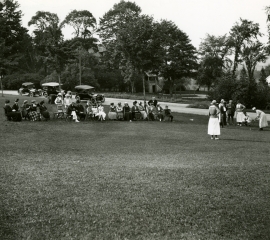dents. A series of revival meetings in 1871, however, seems to have met with a mixed response; most of the Hill appears to have been swept up by it but a few students seem to have resisted and called for a University Church which they felt would meet the special needs of the campus. Their efforts were fruitless and they were informed that the village church was interested in students and welcomed them to all its activities.
The village people took pride in “their”
university and many watched with zest the growth of “college spirit”
and customs. Since so many of the students were preparing for the ministry the prevailing atmosphere continued still to be more earnest than that on other campuses. The subtle changes which were creeping in, however, brought a more carefree outlook. Through their contacts with college friends at Hamilton, Syracuse and elsewhere, and through reading the regular coverage of college news in the Madisonensis, students kept abreast of developments on the “collegiate scene.”
Madisonensis editors often deplored the lack of college spirit but one, alarmed in 1883 at what he thought was an over-emphasis of “college ‘tone:”
asked “whether the extreme type of college man, with his college fashions, his college slang, his inane college gossip, his peculiar college mannerisms, is not as complete a snob, as poor a creature, as exists.”
Neither he nor other alarmists could prevent Madison students from adopting current practices and customs.
Distinctive college garb was introduced as early as 1870, when freshmen announced their intention of wearing “Oxford caps,”
which would seem to have been mortarboards. By 1881 all classes had them, each class identified by the color of the tassel-senior, purple; junior, blue; sophomore, red; and freshman, green. One student urged without results, that the seniors should wear gowns and another that the faculty adopt academic costume as was the practice at other institutions.
Madison’s colors, blue and magenta, adopted in 1868, were changed in 1886 by the Students Association to maroon and orange. They were a conspicuous means of fostering enthusiasm at athletic events and a feature of college life which was especially interesting to the young ladies who followed the fortunes of the teams, especially baseball.
College slang, of course, infiltrated the campus and Madison students seem to have made at least two unique contributions. One was






